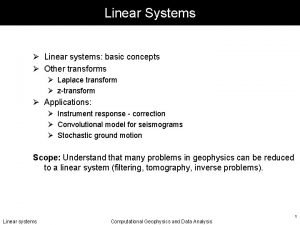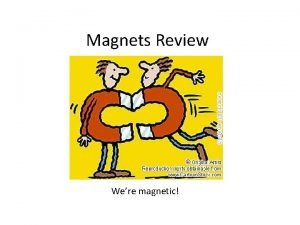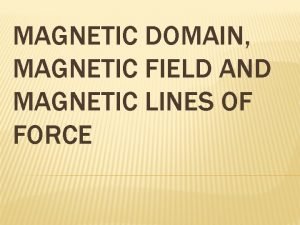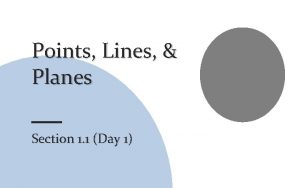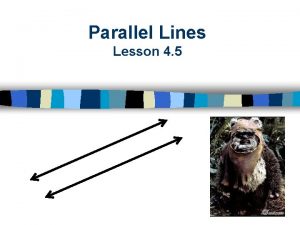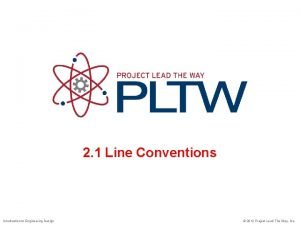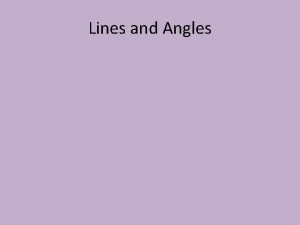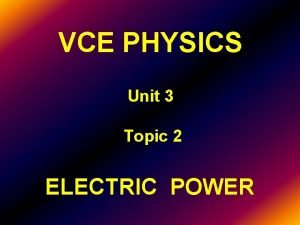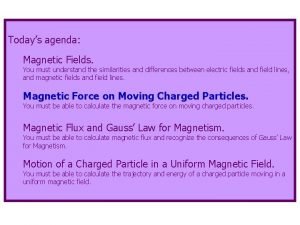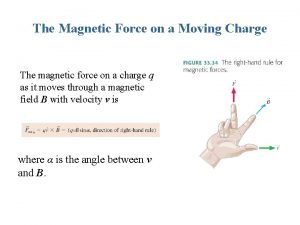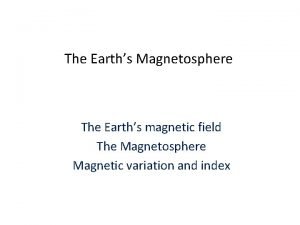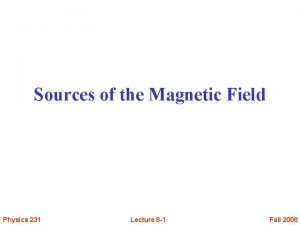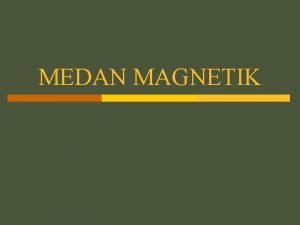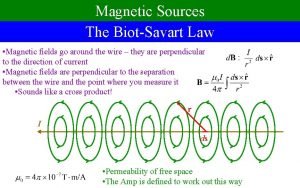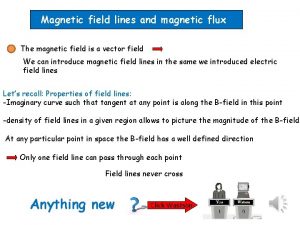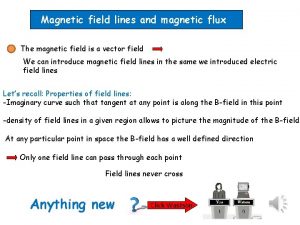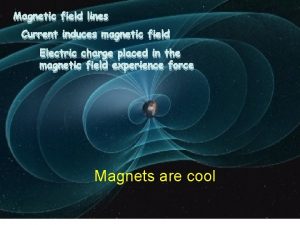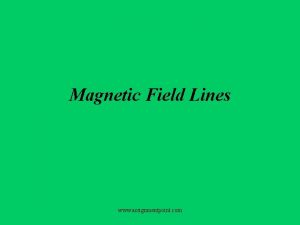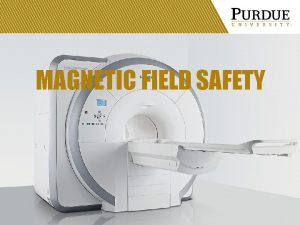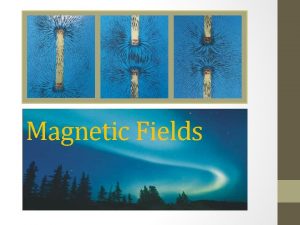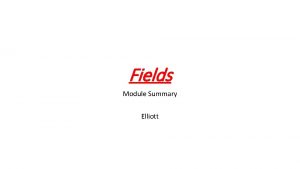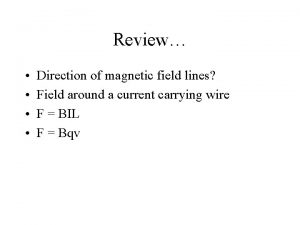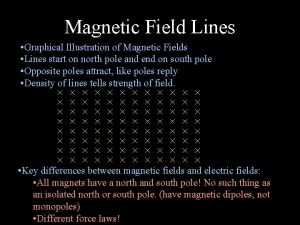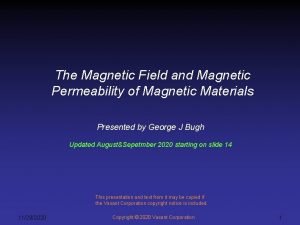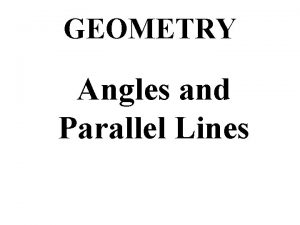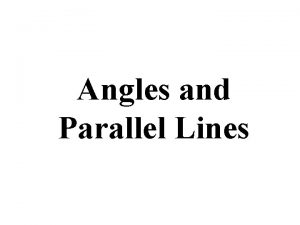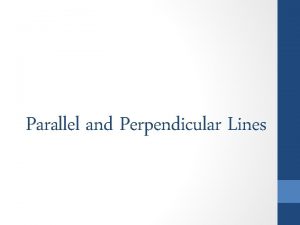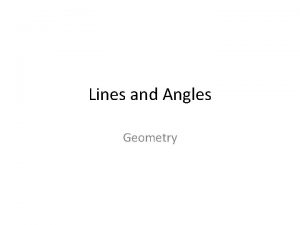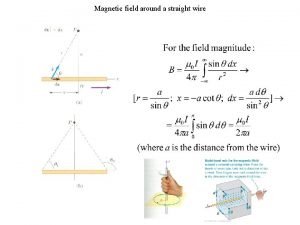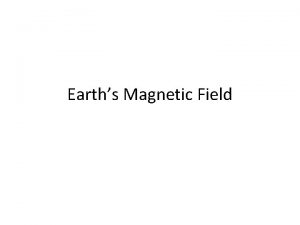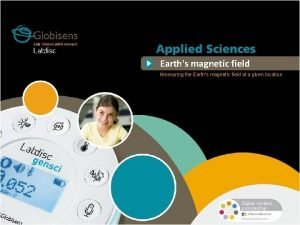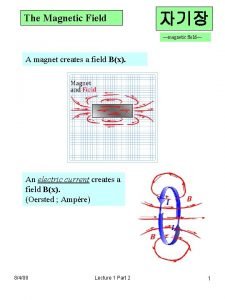MAGNETIC DOMAIN MAGNETIC FIELD AND MAGNETIC LINES OF












































- Slides: 44

MAGNETIC DOMAIN, MAGNETIC FIELD AND MAGNETIC LINES OF FORCE

MAGNETIC DOMAINS �Most materials cannot be magnetized. Iron and a few other materials such as steel, nickel and cobalt can be magnetized. These materials have regions called magnetic domains.

MAGNETIC DOMAINS �Magnetic domains, which are clusters of many atoms, can be thought of as tiny magnets. Substances that can be magnetized can be thought of as consisting of many tiny magnets.

How does the arrangement of the “tiny magnets” differ between the unmagnetized and magnetized substances?

LOOK AT THIS! BEFORE: When the material is unmagnetized, the domains are not lined up in a definite way. They are randomly arranged.

LOOK AT THIS! AFTER: When the material is magnetized, the domains line up in a definite pattern. All the north poles point in one direction, and the south poles in the other.

LOOK AT THIS! BEFORE: AFTER:

CLASSIFICATION OF MATERIALS ACCORDING TO THEIR ATTRACTION TO MAGNETS FERROMAGNETIC - materials which are strongly attracted to a magnet, example is alnico � PARAMAGNETIC – substances which are so weakly attracted by a magnet that normal conditions even a very strong magnet seems to have no effect on them. � DIAMAGNETIC – materials that were repelled by magnets although they themselves were not magnets. They were discovered by Michael Faraday. � FERRIMAGNETIC – they are strongly magnetic but good electrical insulators. �

SUBSTANCE OR MATERIALS ATTRACTED TO A MAGNET REPELLED BY A MAGNET FERROMAGNETIC DIAMAGNETIC Strongly attracted e. g. Iron Nickel Cobalt Heusler’s alloys PARAMAGNETIC Very Weakly Attracted e. g. Platinum Aluminum Manganese Liquid Oxygen FERRIMAGNETI C Strongly Attracted but Electrical Insulators e. g. Ferrites Ceramics e. g. Glass Copper Silver Gold Antimony Mercury Water Bismuth

SHAPE OF MAGNETS Disc

Horse-shoe magnet

Rod Cylindrical

Block Ring

Bar U-shape

Shapes of Magnets U-shape Horse-shoe Block Disc Ring Bar Cylindrical

Magnets

WHAT IS MAGNETIC FIELD ?

FROM THE PAST LESSONS. . � What is gravitational field? � What is magnetic domains? � What are the classification of materials according to their attraction to magnets?

MAGNETIC FIELDS �A magnetic field is the region in space around a magnet in which its force affects another magnet or other magnetizable objects.

� Magnet has the ability to attract or exert force on objects at a distance through its field.

MAGNETIC FIELDS �A good picture of a magnetic field can be made by sprinkling iron filings around a magnet.

EXAMPLE OF MAGNETIC FIELD

North Geographic Pole ` South Magnetic Pole Approximate location: 72°N, 97°W North Magnetic Pole 1, 800 miles , Northwest of the South Geographic Pole Located at Mc. Clintock Sound, north of Hudson Bay Approximate Location; 68°S, 148°E South Geographic Pole

EVERY MAGNET HAS ITS OWN MAGNETIC FIELD.

� Figure A: Figure B: 1. Trace the path of the iron filings in each figure. 2. What do you observe? ______________ 3. In which part do field tracer grains cling most? 4. In which part do they appear dispersed? 5. Is magnetic lines of force confined in only one place? Why or why not?

�The magnetic field changes the filings into little magnets that attract one another. This makes the filings form long and thin chains. The chains line up in the shape of the magnetic field.

Fig. A: Bar Magnet Figure A shows the magnetic field around a bar magnet. The arrowheads show the direction of the magnetic lines of force, which come out of the N pole and enter the S pole. The concentration of lines of force at the poles shows that the field is strongest there.

Figure B shows the magnetic field around a Ushaped magnet. The shape crowds the lines of force together in between the two poles. This means that the magnetic force between the poles becomes very strong. This is also the reason why a horseshoe magnet can lift greater weights than a bar magnet. Fig. B: U-shaped magne

FIG. C: MAGNETIC LINES OF FORCE (A) BETWEEN TWO UNLIKE POLES (B) BETWEEN LIKE POLES (a) (b) In studying magnets in 1820 s, Michael Faraday described magnetic fields through magnetic lines of force (Fig. C) Magnetic lines of force never overlap even when the poles of the two magnets are brought close to one another.

�At what point around the magnets are the magnetic field lines closer together or the margaha cling most?

� More lines of induction are found at the poles than at points farthest away.

The greater the flux perpendicular unit area, the MAGNETIC FLUX Ф stronger the magnetic field. Around a magnet, the strength and direction of the magnetic field vary. At any point around a magnet, the field has a magnitude or strength which depends on the magnetic flux per unit area Ф/A. The direction is shown by the North pole of the compass needle. Hence, the magnetic field is a vector quantity. It is represented by B. In symbols, the magnetic field at a point is expressed as: B= Ф/A. The unit of flux is the weber and that of the field is the tesla. From the above equation, we can say that 1 tesla = 1 weber/m 2.

MAGNETIC FLUX � The number of lines passing through a perpendicular area reflects the strength of the magnetic field at that portion. � The number of group lines passing through a unit area is called magnetic flux (Φ). � Weber is the unit of magnetic flux. � Tesla – unit of magnetic field

ACTIVITY NO. 3 Electricity and Magnetism I. ARRANGE THE JUMBLED LETTERS TO FORM THE WORD(S), THAT BEST FITS THE STATEMENT. � � � � � 1. Natural magnets - COILAN 2. Clusters of many atoms that act as tiny magnets in a material MAINODS 3. A region around a magnet - SFILEDGENAMICT 4. Imaginary lines that represent magnetic field SLIENSOFGENTAMICFOECR 5. Materials that are strongly attracted to magnet GENTAMICORREF 6. Materials that are repelled by magnet - GENTAMICIAD 7. Materials that are slightly attracted by magnet GENTAMICARAP 8. A substance that possesses magnetic properties - NETGAM 9. Iron and other elements can become strongly magnetized NETGAMITAZIONT

II. COMPLETE EACH STATEMENT BY SUPPLYING THE CORRECT TERM OR PHRASE. � � � � � 1. The N pole of a magnet will be attracted to the _____ pole of another magnet. 2. Alloys and ceramics are used to make _______magnets. 3. The S pole of the earth’s magnetic field is located in ____. 4. Many magnetic lines of force go into a magnet at its ____. 5. A suspended solenoid will rotate until it is lined up with the earth’s ______. 6. Regions containing groups of atoms that act like small magnets are called____. 7. The relationship and interaction between electricity and magnetism is called______. 8. Like poles of magnets ____each other. 9. ______ are objects that attract material containing iron and they always face the same direction when moving freely. 10. Natural magnets are made of iron ore called ____.

III. ANSWER THE FOLLOWING It is a giant magnet 2. In what part of the magnet do lines of force concentrate? 3. It is the number of group lines passing through a unit area. 4. What is the unit of magnetic field? 5. What is the unit of magnetic flux? 6 -10 Give uses of magnets 1.

. CHOOSE THE LETTER(S) OF THE BEST ANSWER 1. The N pole of a compass needle points to the south magnetic pole of the earth because that pole is a. an S pole b. an N pole c. a large iron deposit d. near the north geographic pole 2. If the poles of two magnets repel each other a. both poles must be S poles. c. one pole is an S and the other is an N. b. both poles must be N poles. d. both poles are of the same kind. 3. Magnetizing a piece of iron is a process by which � a. magnetic atoms are added to the iron. c. existing atomic magnets are brought into line. � b. magnetic lines of force are brought into line. d. each atom in the iron is converted into a magnet. 4. A magnetic field can make a compass needle turn because the field � a. attracts N poles. c. comes from the center of the earth.

5. The iron atom acts as a magnet because � a. it has an equal number of protons and electrons. c. the electrons have negative charge. d. the neutrons have no b. the electrons have a spinning motion. charge. 6. A steel sewing needle can be made into a magnet by � a. banging it on a table. c. placing it near a compass. � b. soaking it in mercury. d. stroking it with a magnet in one direction only. 7. If a magnet is brought near a magnet suspended on a string, the � a. N poles attract each other. c. S poles attract each other. � b. N poles attract the S poles. d. N poles repel the S poles. 8. The lines of force of unlike poles placed near each other � a. curve away from each other. c. cancel each other. � b. connect the poles. d. none of these. �

9. A device that turns electric energy into sound energy is � a. a speaker b. a generator c. a VCD player d. a transformer 10. A piece of copper cannot be made into a magnet because � a. copper cannot be charged. � b. the domains are already aligned. � c. the copper atoms have no charge. � d. electrons spinning in opposite directions in copper cancel each other.

ANSWER KEY I 1. 2. 3. 4. 5. 6. 7. 8. 9. 10. Alnico Domains Magnetic fields Magnetic lines of force Ferromagnetic Diamagnetic Paramagnetic Magnetization Poles

II 1. 2. 3. 4. 5. 6. 7. 8. 9. 10. South Permanent North geographic pole/ North pole Pole Magnetic field Domains Electromagnetism Repel Ferromagnetic Lodestone/ Magnetite

III 1. 2. 3. 4. 5. 6. 7. 8. 9. 10. Earth Poles Magnetic flux Tesla Weber Compass Speaker Motors, computers memory, decorative materials Generators Electric fan

IV. MULTIPLE CHOICE 1. D 2. A, B, D 3. C 4. D 5. B 6. D 7. B 8. B 9. A 10. D

ASSIGNMENT How does electricity and magnetism related to each other? � What is an Electromagnet? � What is/are common between a permanent magnet and an electromagnet? � How are electromagnets different from the permanent magnets? � Factors affecting the magnetic field strength � Electromagnets at work PHYSICS, SEMP pp. 194 -202 �
 Electric field and magnetic field difference
Electric field and magnetic field difference Distinguish between magnetic and nonmagnetic materials
Distinguish between magnetic and nonmagnetic materials Magnetic field
Magnetic field Magnetic moment and magnetic field relation
Magnetic moment and magnetic field relation Flux density unit
Flux density unit F=i(lxb)
F=i(lxb) Right hand grip rule
Right hand grip rule Cow magnet magnetic field
Cow magnet magnetic field Magnetic field lines always cross.
Magnetic field lines always cross. Magnet has two poles
Magnet has two poles When is magnetic field zero
When is magnetic field zero Domain codomain range
Domain codomain range What is time domain and frequency domain
What is time domain and frequency domain Language processor mcq
Language processor mcq Database field types and field properties
Database field types and field properties Field dependent and field independent
Field dependent and field independent Magnetic field intensity formula
Magnetic field intensity formula Draw and label a picture of the earth's magnetic field
Draw and label a picture of the earth's magnetic field Nuclear notation
Nuclear notation Kinetic energy and magnetic field
Kinetic energy and magnetic field Dot and cross in magnetic field
Dot and cross in magnetic field Z domain to frequency domain
Z domain to frequency domain![What is the z - transform of anu[n] and -anu[-n-1] What is the z - transform of anu[n] and -anu[-n-1]](data:image/svg+xml,%3Csvg%20xmlns=%22http://www.w3.org/2000/svg%22%20viewBox=%220%200%20200%20200%22%3E%3C/svg%3E) What is the z - transform of anu[n] and -anu[-n-1]
What is the z - transform of anu[n] and -anu[-n-1] Z transform tutorial
Z transform tutorial Domain specific vs domain general
Domain specific vs domain general Domain specific vs domain general
Domain specific vs domain general Problem domain vs knowledge domain
Problem domain vs knowledge domain S domain to z domain
S domain to z domain The coercive force in a ferromagnetic material is
The coercive force in a ferromagnetic material is Individual differences factors
Individual differences factors Field dependent vs field independent
Field dependent vs field independent Waveguide cutoff frequency
Waveguide cutoff frequency What is magnet
What is magnet Define magnetic domain
Define magnetic domain Worksheet 1-1 points lines and planes day 1
Worksheet 1-1 points lines and planes day 1 Parallel lines and planes
Parallel lines and planes Convention of lines
Convention of lines Define parallel lines and intersecting lines
Define parallel lines and intersecting lines Right hand palm rule magnetic field
Right hand palm rule magnetic field Magnitude of magnetic force
Magnitude of magnetic force Integral of magnetic field
Integral of magnetic field Magnetic field equation
Magnetic field equation Magnetic field unit
Magnetic field unit Arah momen dipol
Arah momen dipol Magnetic field of a finite wire
Magnetic field of a finite wire







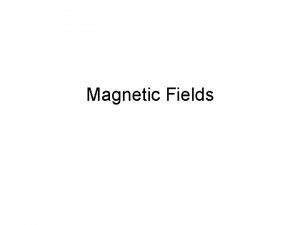
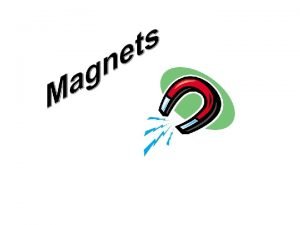
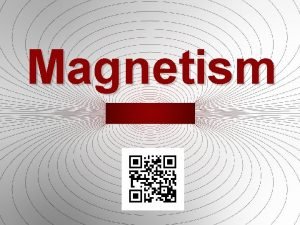






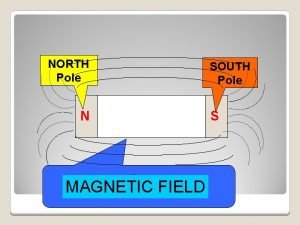
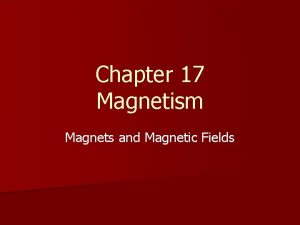
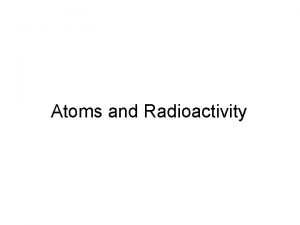
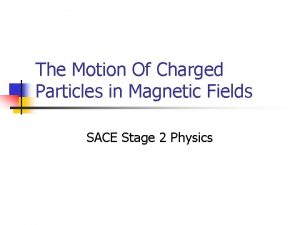


![What is the z - transform of anu[n] and -anu[-n-1] What is the z - transform of anu[n] and -anu[-n-1]](https://slidetodoc.com/wp-content/uploads/2020/12/2676408_bc1105d747f6a28db864208443624449-300x225.jpg)




